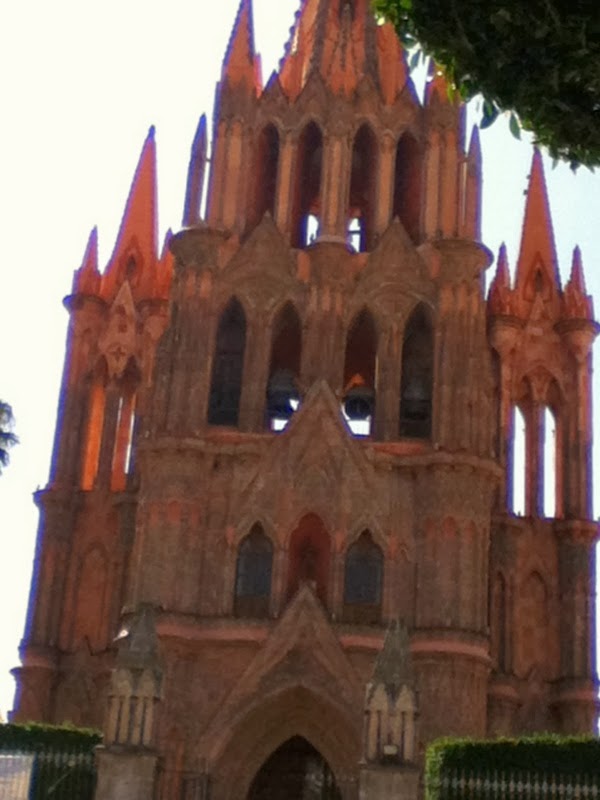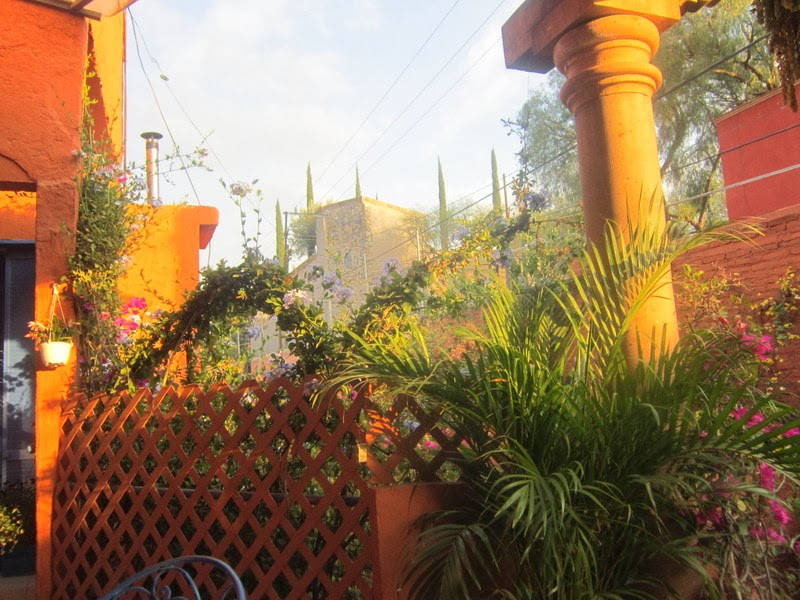.JPG) |
| Colorful San Miguel. Streets, shops, decorative arts, Katrina shop, an outdoor cafe, Elissa and friend Gay; with Don Quijote; in new t-shirt; beautiful carvings, wall painting |
"Oh, look, another VW bug. I've never seen so many in one place." Elissa started taking pix of the old cars, once made in Mexico, still chugging along the cobble-stoned streets.
"Wow, what beautiful doors."
It was daughter Elissa's first trip to San Miguel de Allende, Mexico, and she loved everything she saw and experienced, not to mention the perfect weather. All the sights and sounds; the hilly ancient streets, the architecture, arts and crafts,shops and restaurants, and "the best margaritas, just like Aunt Andy said!"
 |
| The Parroquia |
Always aglow and striking, it towers over the Jardin and dominates the skyline. "Follow the Parroquia and you can't get lost," I assured her. "Well, I don't have to pay much attention to directions, with my good tour guide!" But Elissa got the geography of the town down pretty well, almost as much as her menu instructions (no gluton, no dairy).
On the food front,where there could have been some misunderstanding, there was no trouble. No wheat, no milk, no butter, no cheese, no dairy. She gave her list, in Spanish, and waiters were happy to oblige, talk to the cook, bring out the cook, explain the food. "I have it down," she'd say, after her stream of excellent Spanish. We had some great meals, at Hecho en Mexico, Cafe Jardin (with some nice jazz), Cafe Monet (where we heard fabulous pianist Alejandro Mora), and Mexifran (where we plied the guitarist with tequila and had some great fun!). There's lots of ways to cook chicken, steak and fish, with corn torilla and quacamole, steamed veggies and various fruity sauces, Elissa found out. Food and music! "Viva Mexico!"
 |
| Talavera pottery at the Artesenias Mercado. |
We took in historic sites, went into churches, visited the Biblioteca, galleries, Bellas Artes and the Instituto. The art is exquisite, from pre-historic, to colonial, to contemporary. The murals are fantastic. At the Instituto, we happened upon a great textile exhibit by weaver Elizabeth Starcevic, as well as the works of one of Mexico's (and my) favorite artists, David Leonardo. We had a nice chat with David's agent, who explained the difference between "mamacita," which Elissa calls me, and "mamita," which he calls his mom. I told her both were acceptable, one being a voluptuous sexy woman (ooh-la-la), and the other a beloved mama, Juan said.
We happened by a brand new exhibit of Polish posters, of all things, as we walked down Zacateros to Mesa Grande, the wifi cafe. The posters were collected by Dr. Martin Rosenberg, "the largest and most complete selection of pre-war and vintage Polish cultural posters in existence." The Rosenberg Collection is huge; the posters are noted for their originality, artistry, brilliance. "The exceptional Polish poster is...a work of art rather than a conventional advertising placard," notes Elena Miller, a retired Curator of Posters at the Library of Congress in Washington, DC. Their bold designs and bright colors fit into San Miguel.
 |
| Polish graphic art posters |
"Why are the posters here? Why did you open a gallery in San Miguel? she asked him. "Because I moved here after retiring, and brought them with me!" Thousands upon thousands of them. Lucky for San Miguel.
Elissa talked to lots of artisans and shopkeepers. Among the most interesting was Juan at the Katrina gallery, which is packed with those colorful skeleton dolls associated with the Mexican "Day of the Dead." Mexicans have a special relationship with death, as with life; nowhere is death more openly acknowledged and celebrated as it is there. Elissa selected a beautiful ceramic doll for her daughter Julia, and Juan regaled us with her history as he carefully wrapped her. The history goes back to the late-nineteenth century in Europe and Spain and was popularized in Mexico by Diego Rivera's famous mural "Dream of a Sunday Afternoon along Central Alameda." The mural beautified a large government building in central Mexico City, which was destroyed by a horrendous hurricane in 1985. It means something that the mural survived, but the building did not. From Rivera's perspective, the Katrina, as she is called in Mexico, is related to an Aztec tradition, in which she is "Keeper of Bones" in the underworld and presides over festivals honoring the dead.
 |
| Doors and decorations; tapestry exhibit at Instituto; Church of San Francisco; balloons and toys in Jardin, mountains in background; carving on a corner building. |
"Anything else you want to see?" I asked on our last day. "I just want to get an 'I Love Mexico' T-shirt," she said with a laugh. And sure enough, that's what we did!


No comments:
Post a Comment